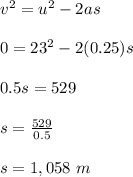
Physics, 16.10.2020 15:01 Nolanrdavis
What distance is required for a train to stop if its initial velocity is 23 m/s and its deceleration is 0.25 m/s²? (Assume the train decelerates at a constant rate.)

Answers: 1


Another question on Physics

Physics, 21.06.2019 14:50
Use the empirical rule. the mean speed of a sample of vehicles along a stretch of highway is 70 miles per hour, with a standard deviation of 4 miles per hour. estimate the percent of vehicles whose speeds are between 66 miles per hour and 74 miles per hour. (assume the data set has a bell-shaped distribution.)
Answers: 3

Physics, 22.06.2019 05:00
Which car has the most kinetic energy? a. a car of mass 1000 kg with a speed of 3 m/s b. a car of mass 2000 kg with speed 7 m/s c. a car of mass 1000 kg with speed 7 m/s d. a car of mass 2000 kg with speed 3 m/s
Answers: 1

Physics, 22.06.2019 14:30
Which of the following changes will increase the capacitance of a parallel-plate capacitor? (there could be more than one correct choice.) a) increase the charge on the plates b) decrease the poten5al between the plates c) increase the potential between the plates d) introduce a dielectric material between the plates e) decrease the separation between the plates
Answers: 3

Physics, 22.06.2019 14:50
Nitrogen (n2) undergoes an internally reversible process from 6 bar, 247°c during which pν1.2 = constant. the initial volume is 0.1 m3 and the work for the process is 121.14 kj. assuming ideal gas behavior, and neglecting kinetic and potential energy effects, determine heat transfer, in kj, and the entropy change, in kj/s. show the process on a t-s diagram.
Answers: 2
You know the right answer?
What distance is required for a train to stop if its initial velocity is 23 m/s and its
deceleratio...
Questions


Mathematics, 10.04.2020 15:27


Computers and Technology, 10.04.2020 15:27









Engineering, 10.04.2020 15:28











